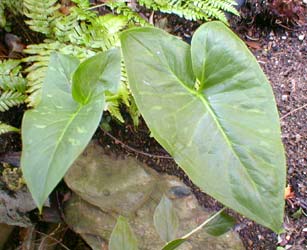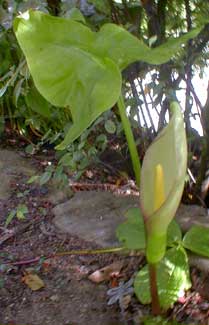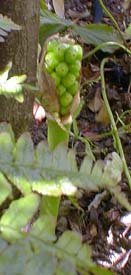
Plain-leafed Large Lords & Ladies;
or, Crimean Cuckoopint
"This is the arum which within its root
Folds life & death."
-Charles Mare
(1838-1927)
(1838-1927)
The subspecies Arum italicum albispathum is native of the Black Sea region. Compared to the more commonly offered mottled arum (A. italicum italicum 'Pictum'), it has larger wider unmarked arrow-leaves that emerge earlier in Autumn (showing themselves in September & very large & lively by mid-October, well ahead of 'Pictum' in our garden at least). 'Albispathum' settles more quickly into the garden & is quicker to produce the colorful seed-cobs, & is even more winter hardy (to Zone 5) than 'Pictum' (delicate in Zone 5).
We've a third variety (A. italicum italicum 'Silver Shield') which is even shorter than 'Pictum' & practically a dwarf compared to 'Albispathum.' 'Silver Shield' has fat rounder leaves instead of the expected arrowleaves.
 The most curious ability of an arum is to warm itself with its flower, which to the touch feel warmer than the ambient temperature of the atmosphere. On particularly cold nights, the leaves fold upon themselves to preserve its own warmth.
The most curious ability of an arum is to warm itself with its flower, which to the touch feel warmer than the ambient temperature of the atmosphere. On particularly cold nights, the leaves fold upon themselves to preserve its own warmth.The first leaf portrait is from October. The flower photo is from the following June. The May & June flower spathes are large, white on the inside, setting off the upright yellow spadix most dramatically, & greenish-white on the outside.
By late spring the spathe will be expiring, but the spadix if properly pollinated will remain, developing into an upright "cob" of berries that are green through summer (shown at left in July) & ripen to the most brilliant orange-red by autumn (same cob shown below right in September).
 After these are autumn ripened, the sturdy stem sometimes softens so that the berry-cob falls over for greater access by ants & beetles. Insects cart away the seeds, clean them by eating all the soft pulp, but leave the seed to establish a new plant at some distance from the parent. Birds & squirrels will disperse the seeds further still. Arums do appear as volunteers in many a garden, the seeds having been brought by insects or animals from other gardens.
After these are autumn ripened, the sturdy stem sometimes softens so that the berry-cob falls over for greater access by ants & beetles. Insects cart away the seeds, clean them by eating all the soft pulp, but leave the seed to establish a new plant at some distance from the parent. Birds & squirrels will disperse the seeds further still. Arums do appear as volunteers in many a garden, the seeds having been brought by insects or animals from other gardens.To grow more arums from these seeds, they should be harvested ripe, the pulp cleaned off, the seed dried, & planted in autumn in coldframes or pots. Because the juice of the plant can be a skin irritant, it's best to wear gloves when cleaning the seeds from the cob.
 Many gardeners complain that arums take so long to spread. It can take years for the central clump to extend itself. But others abhore the species for taking over areas to such an extent that gardeners regret having planted them at all. Our 'Pictum' which is sometimes categorized as a dwarf has remained a small plant with slow spread, but 'Albiflorum' in a single year produced a second plant from its spreading rhizome, & is in every way a larger & more aggressive plant.
Many gardeners complain that arums take so long to spread. It can take years for the central clump to extend itself. But others abhore the species for taking over areas to such an extent that gardeners regret having planted them at all. Our 'Pictum' which is sometimes categorized as a dwarf has remained a small plant with slow spread, but 'Albiflorum' in a single year produced a second plant from its spreading rhizome, & is in every way a larger & more aggressive plant.Under conditions that are especially encouraging for arums, they have been known to crowd out all other plants. If they are regretted, nothing one can do is apt to get rid of them, since any fragment of the root that is missed will generate more plants, & digging around in an area they have taken over will invariably leave many root particles to make a come-back greater than before. Herbicides only temporarily squelch them, & in some areas of Australia & the United States they have become harmful invasives.
Here in Zone 8, however, this just does not seem to occur. Arums are well-behaved & their spread ranges from slow to moderate. If insufficiently watered in deep shade, they can even become stunted. I suspect it is only in warmer zones with moist or humid climate that can cause them to become holy terrors, as no one of my personal acquaintance has ever found them troublesome.
It is the arrowhead-shaped winter leaves for which Arum is most prized in the shade garden. When hostas are vanishing for the winter, the arums are just getting started. Ours are planted among trilliums, dogtooth lilies, arisaems, & other shade plants that have no winter presence, & that garden could well look very empty without the arums among a very few other evergreen shade-plants.
On freezing days or nights of winter, the leaves curl up into tubes to protect themselves, but uncurl when the frost breaks, still good as new. When spring returns, "horns" poke out of the foliage, which open into large white-interiored spathes protecting the yellow spadix which develops miniscule white flowers. Each plant produces both male & female microflowers which are pollinated by flies.
The odor of the flower can be miserable for a couple of days to attract flies, but you have to put your nose in them to experience the misery, & the odor is gone very soon & should not be regarded a discouraging feature.
In all, there is year-round interest from the large arrowhead leaves autumn through spring; the unusual spring cuckoopint flowers; & the summer to autumn "cob" of red berries.
Arums are mildly toxic. The toxin in the tuber, leaves, & flowers is calcium oxylate, which causes considerable burning of the mouth & throat, hence it is rarely bothered by deer. The toxin completely breaks down with drying or cooking, so that the tuber becomes edible. The berries are toxic while green, so that birds or squirrels won't take them until the seeds are ready to be carted off for dispersal. The plant should not be handled aggressively or can irritate the skin, & when cleaning the seeds prior to drying, it is probably best to wear gloves.